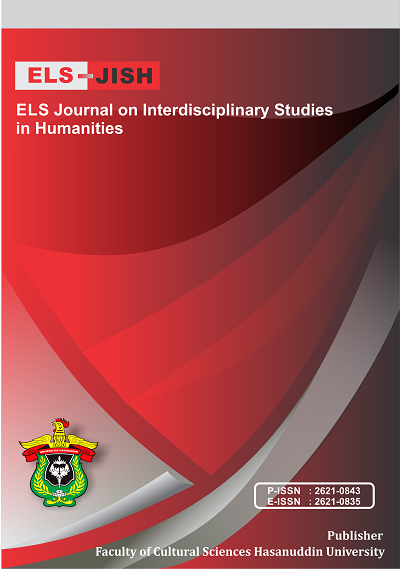The Role of Money and Fashion in Character Building in Confession of A Shopaholic Movie
DOI:
https://doi.org/10.34050/elsjish.v5i4.24576Keywords:
Character, Fashion, Georg Simmel, MoneyAbstract
This article discusses the film Confession of A Shopaholic, directed by P.J. Hogan based on Georg Simmel's sociology of money to dismantle the role of money and fashion in the formation of the main character's character. The purpose of this article is to formulate how money problems can change individual character. Georg Simmel's sociology of money points discussed in this article cover two things, namely money as an institution that supports social stratification and the financial system as part of the evolution of society. Simmel's view of fashion is used to support this research. Research data is taken from scenes or dialogues of the main characters in shopping, including when faced with choices. There is a deep connection between money, fashion, social stratification, and the results of the evolution of society which play a role in building the mentality of society itself. Childhood experiences also shape the individual's passion to fulfill his desires as an adult. The results of the study show that the cooperation between money and goods offered by the market is able to drive the emotional side of the individual and the role of the environment to support individuals in finding awareness
References
Amani, M., & Shabahang, M. J. (2017). The relationship of self-efficacy and money attitudes with mental health: Mediation through Maslow’s hierarchy of needs. International Journal of Culture and Mental Health, 10(3), 310–319. https://doi.org/10.1080/17542863.2017.1314517
Beer, D. (2019). Georg Simmel’s Concluding Thoughts: Worlds, Lives, Fragments. Cham: Springer International Publishing. https://doi.org/10.1007/978-3-030-12991-0
Blumenberg, H. (2012). Money or Life: Metaphors of Georg Simmel’s Philosophy. Theory, Culture & Society, 29(7–8), 249–262. https://doi.org/10.1177/0263276412455230
Boy, J. D. (2021). ‘The metropolis and the life of spirit’ by Georg Simmel: A new translation. Journal of Classical Sociology, 21(2), 188–202. https://doi.org/10.1177/1468795X20980638
Cassano, G. (2005). Reification, Resistance, and Ironic Empiricism in Georg Simmel’s Philosophy of Money. Rethinking Marxism, 17(4), 571–590. https://doi.org/10.1080/08935690500241519
Cheung, F. M. (2008). Relinking Money and Social Support from a Sociocultural Perspective. Psychological Inquiry, 19(3–4), 186–188. https://doi.org/10.1080/10478400802625875
Cohen, D., Shin, F., & Liu, X. (2019). Meanings and Functions of Money in Different Cultural Milieus. Annual Review of Psychology, 70, 475–497. https://doi.org/10.1146/annurev-psych-010418-103221
Dinurriyah, I. S. (2013). An Attempt of Showing Identity or Looking for Identity? A Case Study on Bridget Jone’s Diary, Confession of Shopaholic And Devil Wears Prada. JSGI, 04(01), 8.
Feingold, E., Fourie, J., & Gardner, L. (2021). A tale of paper and gold: The material history of money in South Africa. Economic History of Developing Regions, 36(2), 264–281. https://doi.org/10.1080/20780389.2021.1926232
Hadita, H. (2014). An Analysis on the Function and Accuracy of Coordinate Conjunction and in Translating A Novel Confession of Shopaholic. Wanastra: Jurnal Bahasa Dan Sastra, 6(1), 25–41.
Hogan, P. J. (Director). (2009). Confession of Shopaholic.
Huerta de Soto, J. (2010). Socialism, economic calculation and entrepreneurship. Cheltenham, Glos, UK ; Northampton, MA: Edward Elgar.
Kim, H.-S., & Hall, M. L. (2014). Fashion Brand Personality and Advertisement Response: Incorporating a Symbolic Interactionist Perspective. In Fashion Branding and Consumer Behaviors: Scientific Models (p. 29). New York: Springer.
Kuźniarz, B. (2018). Simmel and the Posthuman: Money as the God of Bad Infinity. Polish Sociological Review, 204(4), 447–462.
Meyrasyawati, D. (2013). Fesyen dan Identitas: Simbolisasi Budaya dan Agama dalam Busana Pengantin Jawa Muslim di Surabaya. Makara Seri Sosial Humaniora, 17(2), 99–108. https://doi.org/10.7454/mssh.v17i2.2955.
Oleson, M. (2004). Exploring the relationship between money attitudes and Maslow’s hierarchy of needs. International Journal of Consumer Studies, 28(1), 83–92. https://doi.org/10.1111/j.1470-6431.2004.00338.x
Puspitasari, D., & Masri, F. A. (2019). Anguage Deception in “Confession of a Shopaholic” Movie by Shopie Kinsella. ELITE: Journal of English Language and Literature, 2(1), 82–89.
Ramadhani, R. P., Hafsah, S., & Prautomo, A. (2019). THE CORRELATION LANGUAGE AND GENDER AS WOMAN’S LANGUAGE IN THE MAIN CHARACTER IN THE CONFESSION OF A SHOPAHOLIC’S MOVIE. Prologue: Journal on Language and Literature, 5(1), 23–43. https://doi.org/10.36277/jurnalprologue.v5i1.29
Sapui, M. (2020). Billions in Debt and Still Surviving": Curing the Female Shopper in Confessions of a Shopaholic. CINEJ Cinema Journal, 8(22), 14–44.
Sepahpour, G. (2015). THE ROLE OF THE INNER CHILD IN PROCESS OF DECISION MAKING FOR PRODUCT SELECTION. DS 80-9 Proceedings of the 20th International Conference on Engineering Design (ICED 15) Vol 9: User-Centred Design, Design of Socio-Technical Systems, Milan, Italy, 27-30.07.15, 301–310.
Simmel, G. (2011). The Philosophy of Money. London and New York: Routledge.
Singh, D. (2016). Speculating the Subject of Money: Georg Simmel on Human Value. Religions, 7(7), 80. https://doi.org/10.3390/rel7070080
Sjöblom, M., Öhrling, K., & Kostenius, C. (2018). Useful life lessons for health and well-being: Adults’ reflections of childhood experiences illuminate the phenomenon of the inner child. International Journal of Qualitative Studies on Health and Well-Being, 13(1), 1441592. https://doi.org/10.1080/17482631.2018.1441592
Surowiecki, J. (2012). A brief history of money. IEEE Spectrum, 49(6), 44–79. https://doi.org/10.1109/MSPEC.2012.6203967
Wang, X. (2015). Simmel’s View on the Conflict between Life and Money as a Cultural Form. Journal of Changsa University of Science and Technology.
Xie, W., Yu, B., Zhou, X., Sedikides, C., & Vohs, K. D. (2014). Money, moral transgressions, and blame. Journal of Consumer Psychology, 9.
Zelmanovitz, L. (2010). The theory of money value and monetary evolution for Simmel and Mises. REVISTA PROCESOS DE MERCADO, 147–174. https://doi.org/10.52195/pm.v7i2.275
Downloads
Published
Issue
Section
License
Copyright (c) 2022 Nimas Kharisma Mahanani, Johny Alfian Khusyairi

This work is licensed under a Creative Commons Attribution-NonCommercial-ShareAlike 4.0 International License.






